1971 United States Grand Prix
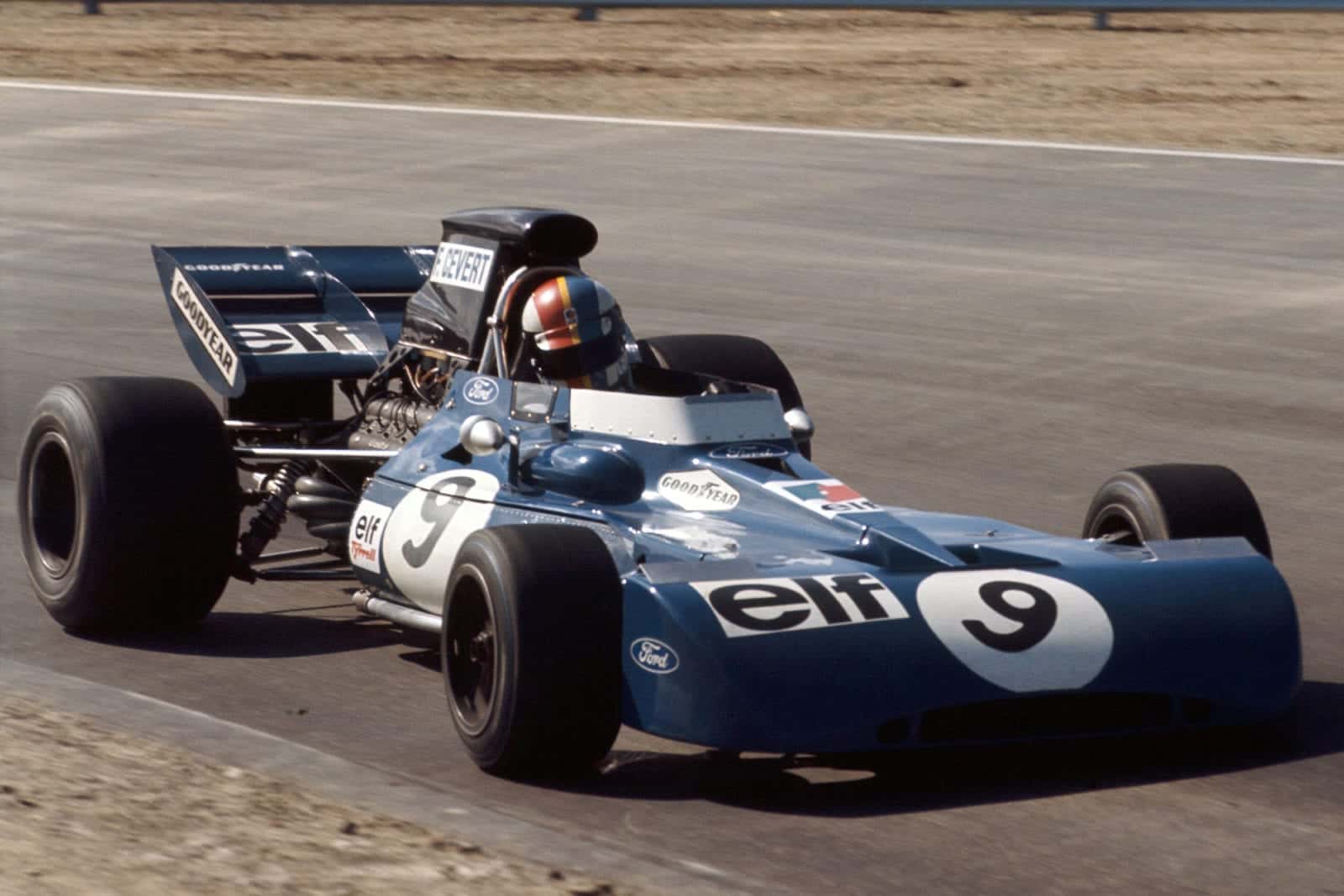
Francois Cevert took his debut win for Tyrrell at Watkins Glen
Motorsport Images
Cevert’s first Formula One victory
Watkins Glen, October 3rd
What a tremendous season Elf-Team Tyrrell have had in 1971. Their number one driver Jackie Stewart collected the World Championship crown with six victories to his credit, the marque Tyrrell won the Constructors Championship by a country mile and to cap it all their number two, Francois Cevert, scored his maiden Grand Prix victory at Watkins Glen after little over a year in Formula One. It was a just reward for the young Frenchman who has proved to be such an excellent shadow of Stewart on the track, who has scored two fine second places and who proved his skill with a shattering lap record at the Nurburgring. The Watkins Glen victory was worth a record sum of over $65,000 for the team run by Ken Tyrrell, with cars designed by Derek Gardner prepared by chief mechanics Roland Law and Roger Hill in premises that many would turn their noses up at. The Tyrrell team were first in practice and the early laps with Stewart, and then for the remainder of the race with Cevert, totally dominated this year’s closing Grand Prix.
Everyone tries especially hard to do well at the Grand Prix of the United States for it is here that a season’s profit or loss can be made. First prize is $50,000, the runner-up can expect $20,000, third man $12,000 and from then on downwards to $6,000 for the first man to retire, far more than the teams could ever expect in Europe. The organisers afford it because their publicity machine is able to tempt a genuine 100,000 people to the circuit paying an average of about $12 each for the privilege and because the Grand Prix Corporation is a non-profit-making organisation which, thanks to the enthusiasm of the people concerned, happens to work here.
This year was an important one in the history of the race for the circuit had been completely revised so that with new pits, widened track for its complete length and a well designed and difficult undulating extra mile it was very hard to recognise the circuit as the same place. The extra width and length also had the advantage that a larger number of cars could be raced and 29 plus one reserve entry was accepted.
Substantially the list was the same as at Mosport Park two weeks earlier but there were some additions plus a driver change or two. Numerically the order was as follows with last year’s winner, Emerson Fittipaldi heading the list at number 2 (No. 1 was left blank in memory of Rindt). Thus Wisell was next up and the pair were in their regular Lotus 72s in D specification although Fittipaldi’s car was built in 1970 and Wisell’s this year.
Ferrari brought along the three B2 models for Ickx, Regazzoni and Andretti plus the faithful last of the B1s which both Regazzoni and lckx rush to drive if they have the slightest opportunity. This was rather a touchy subject in the Ferrari camp particularly when a copy of an Italian magazine claiming the older car to be better was produced. In fact lckx raced the 1970 B1 in the end just as he had done at Monza.
Andretti had something of a problem on his hands for the week before Watkins Glen he was scheduled to drive for the STP team at the USAC Championship race in Trenton, New Jersey and this had been rained off. A new date was fixed for a week later with obvious complications for the commitment with Trenton was more binding than Watkins Glen. Andretti made it blatantly clear that he would far rather race the Ferrari and turned up tor practice hoping and praying the Trenton race would be rained off for a second week running which, according to the weather forecasters, was a distinct possibility.
In exactly the same situation was Mark Donohue who had driven so well in the Canadian GP with the Penske/White McLaren M19A bought from the works but still under their influence. However Penske nominated his British second string driver David Hobbs as a reserve, Hobbs previously having Grand Prix experience in rather uncompetitive machines like the Bernard White Racing BRM of three seasons back. Also in a McLaren M19A was Denis Hulme who was in high spirits following his first Can-Am victory for some months the previous weekend.
For the first time since 1969 the Tyrrell Organisation decided to run three cars in addition to Stewart in 003 and Cevert in 002, Peter Revson was co-opted into the team to drive Stewart’s usual spare, the faithful 001. Revson was a familiar if not successful face in Formula One in Europe in 1964 and since then has concentrated most of his efforts on American racing culminating in a highly successful association with McLaren Racing this season in both Can-Am and USAC racing.
The Matra-Simca team from France were little changed with the regular blue MS120Bs for Amon, whose growth of beard, first seen at Monza, had been shaved off. Perhaps he should have kept growing it until he won a Grand Prix!
Just as in Canada, Yardley-BRM were at full five-car strength with all four P160s and also the last of the P153s. Siffert, Gethin and Ganley were all in their regular cars while Austrian Helmut Marko received a kind of promotion by moving up from the P153 to the fourth P160, the car driven by George Eaton in Canada. Meanwhile P153 found a willing pilot in the form of fellow Canadian John Cannon who has been threatening a Grand Prix début for a race or two but who had made his Formula One début at the Questor GP in a March 701 earlier in the year. All the P160s finished up with Mk. 2-headed engines but no short-strokes. There were whispers of Aubrey Woods’ imminent departure from the team but another member of BRM’s engine design staff was present.
John Surtees’ Edenbridge firm were fielding three TS9s on this occasion for, following Monza, the latest side-radiator version TS9/005 had undergone a test programme which proved successful. Gone was the cow-catcher front but a different make of radiator plus louvres in the top of the ducts to encourage the extraction of hot air seemed to be doing the trick, and Surtees was happy with the car. In the car raced by Surtees in Canada was Mike Hailwood fresh from his excellent showing for the team at Monza but the Eifelland-sponsored car posed a problem. Rolf Stommelen had gone down with a jaw infection and was under doctor’s orders, thus ending his unsuccessful association with the team a race early, and Surtees decided to nominate a replacement driver. He had two in mind, Dutchman Gijs van Lennep who had done such a good job in the rent-a-TS7 at Zandvoort in the rain and American Sam Posey who finished runner-up in the Continental Championship driving one of Surtees’ TS8 Formula 5000 cars. In the end Surtees brought them both to the circuit to try the car and delayed a final decision until after final practice.
Despite trying hard, Ron Tauranac’s first season without Jack Brabham has brought little reward for the hard work. The team was headed as usual by Graham Hill in the unique Brabham BT34 while Tim Schenken was in his regular BT33. In between the two North American races the pair had been back to Europe for the Formula Two race at Albi where driving the Rondel team Brabhams they had come into contact with each other when contesting the lead—thus they were eyeing each other rather suspiciously. A third entry under the Motor Racing Developments banner was made for Chris Craft in Ecurie Evergreen’s Brabham BT33 although Tauranac was leaving them mainly to their own problems which were considerable although Craft used an engine borrowed from the works in practice.
The STP-March outfit were obviously hoping to finish the season on a bright note and had a trio of 711s for Peterson, Galli, and de Adamich. De Adamich’s 711/1 was back with an Alfa engine in the rear following its use by Beuttler in Canada, and this latest V8 from the Italian firm seemed the best yet although there was little incentive with de Adamich announcing he would be driving a Surtees-Cosworth next season.
Again Peterson had the new shovel nose to try and again it did few laps but a new one-piece rear-wing lasted throughout. Pescarolo had recovered from his neck-damaging accident in practice for the Canadian GP. The Williams team, having suffered the ignominy of all three of their F2 cars failing to qualify at Albi, were hoping for better things with their 711, while a similar private March 711 was entered for Skip Barber by the Gene Mason Racing/Triple R Oil Filters outfit. Barber was the first and only reserve and was guaranteed a run if it didn’t rain at Trenton. Finally Pete Lovely came along with his hybrid Lotus Special, the jovial 46-year-old American’s crew all wearing Pete Lovely Fan Club tee-shirts (someone cares), and Jo Bonnier made another of his spasmodic Grand Prix appearances with the almost vintage McLaren M7C. It was unlikely either of these two cars had the fuel tankage to take them through the race without a stop but Lovely at least had taken the precaution of fitting a special quick release filler for his car and planned a stop.
Qualifying
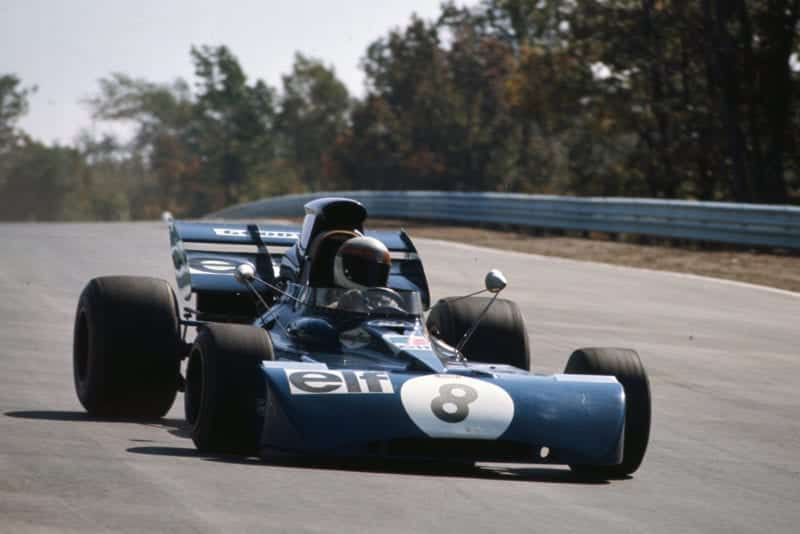
Jackie Stewart took pole
Motorsport Images
Practice was planned to span the two days prior to the race with a four-hour session starting at 1 p.m. on Friday and at mid-day on Saturday, while there had been a free-for-all on the Wednesday although at that stage contractors still had work to finish off including white-lining the sides of the new track, erecting fences and generally building the new timing and press stand. On both official days practice would be stopped if a car became immobile out on the circuit and then recommence when it had been towed in but no allowance made at the end of the session for time lost, which upset some teams a little although with all the time available there was little excuse for not setting up a car.
The main problem in practice was one of tyres for the new section’s bends were all banked and graduates at nearby Cornell University had estimated that a lateral force of 1.74 g was probable on these corners compared with the normal 1.4 g estimate of the latest Formula One’s cornering force. Thus, and with the added ingredient of hot weather, the softer compounds were proving marginal and both Goodyear and Firestone had harder than usual compound tyres on hand if necessary and for once seemed to be keeping their own information very much to themselves. But briefly back to the Cornell University Aeronautical Laboratory’s computer which had been used to assist in the design of the new section of the circuit. The computer had forecast a lap time for the new course of 100 seconds but the interesting booklet published by Cornell on the survey pointed out that, assuming the figures of cornering force, acceleration and deceleration were correct, then this target lap time could only be achieved by the completely fearless driver with perfect anticipation and the ability to place his car exactly on a geometrical line. In practice Stewart lapped just 2.642 sec. slower than the “perfect driver” and one wonders what kind of figure would have been obtained by the computer for the Nurburgring under the conditions when Moss was in his hey-day. The computer also gave target speeds for the various corners and using all this information the Penske team actually geared their McLaren for the ultimate but soon had to drop the ratios.
Practice started with Stewart, Hulme, Amon and Peterson setting the pace but whereas Stewart kept improving to finish up the fastest of the day the others ran into trouble. Amon’s Matra went off-song and both the other cars required engine changes. Hulme’s mechanics claim to have broken the engine-changing record, for under an hour-and-a-half later, the car was circulating. However, what was impressive, was that subsequently nothing fell off and Hulme finished up seventh fastest. Peterson’s mechanics took it easier replacing the team’s now damaged and only 11 series engine and the car was not practising again that day. All the times were being recorded to the 1,000th of a second which only serves to confuse most people. So in this text we will refer to the nearest tenth only although our table indicates all those tiny fractions.
Stewart it was who finished fastest of the day at 1 min. 42.9 sec. while Regazzoni was heading something of a Ferrari revival by being second fastest at 1 min. 43.2 sec. Fittipaldi and the Lotus team in general seemed to be in good form although Wisell did run out of fuel on the circuit. The Brazilian finished up third fastest at 1 min. 43.9 sec. and going noticeably deeper into the tricky corner after the pits than anyone else. Andretti helped Ferrari spirits with a 1 min. 44.1 sec., Cevert was going well at 1 min. 44.3 sec. to head Hulme, while Howden Ganley surprised and delighted everyone with a 1 min. 44.6 sec. but said convincingly that he wasn’t personally all that satisfied. However he very much overshadowed the rest of the BRM team, with Siffert further down the list than usual but not really knowing why (an engine was changed overnight), Gethin who just scratched his head, Marko whose engine developed an oil leak and soaked his back-side in the process and Cannon who found the P153 rather a handful.
After Ganley in eighth, ninth and 10th spots came Beltoise, Surtees and Schenken who seemed reasonably happy. Of the non-regulars Hailwood was working hard and going almost as quick as Surtees but van Lennep (with Posey watching his progress carefully) did not impress, Revson was going quite well with Tyrrell’s oldest and most tired engine and Hobbs only did a few laps before the DFV motor lost its flywheel.
Conditions on Saturday were similar to the previous day with the circuit still dusty in places from contractors lorries and so on but not worryingly so. By this time a huge crowd had already assembled, the great majority of them young people who spurned the costly motels in the vicinity and set up camp in their tens-of-thousands, just as they do at the Nurburgring but very few other places. The weather was perfect for this outdoor life and while the evening brought beer and other things in excess and we witnessed one bloody brawl, the gathering was on the whole very peaceful.
However the peace was shattered at 12 noon by the sound of Formula One racing engines running in anger and soon Stewart and Cevert were out proving the Tyrrell superiority in the opening hour. However Peterson, frustrated by the previous day, soon put himself in the 1 min. 44.0 sec bracket and into the top five or six, and Fittipaldi was proving a threat once again.
Donohue appeared dressed in his overalls although Hobbs was allowed the first couple of hours in the car, while likewise Posey was in his Nomex but he had the first go in the Surtees he appeared to be sharing. Almost immediately he started lapping 3 sec. quicker than the Dutchman’s best. Again the tyre engineers rushed up and down the pit road with worried expressions on their faces, particularly when the teams were doing full-tank tests. With chunking to worry about the vibrations seemed to be forgotten. Incidentally at this circuit Goodyear were using Wolverhampton-made tyres again as they suited the Watkins Glen circuit better than the Akron tyres which had proved successful in Canada.
The last hour of practice was undoubtedly the most exciting with most of the fireworks coming from Fittipaldi who, in a display of tremendously mature and determined driving, carved his time down into the high 1 min. 42 sec. bracket and looked like snatching pole from under Stewart’s nose. With an extra $2,000 at stake the Scot had something to aim for and Tyrrell had immediately picked up the Brazilian’s impressive laps so the World Champion went out and coolly and calmly defended pole position. At any other circuit the pair would have been given equal times but when they were announced officially Stewart had lapped in 1 min. 42.642 sec. and Fittipaldi in 1 min. 42.659 sec. This made a previously very excited Colin Chapman rather upset. However, in the closing stages Denis Hulme had also got into the groove and he hustled the orange McLaren round to complete the front row at 1 min. 42.9 sec. with Regazzoni barely slower at 1 min. 43.0 sec. and he made up the second row with Cevert who had been paced by Stewart.
The third row produced an interesting line-up of different 12-cylinder engines. Mario Andretti seemed heartened by the stories of showers in the Trenton area and worked hard to get his Ferrari as high up the grid as possible in the event of him starting but seemed a little mystified that he was 0.2 sec. slower than Regazzoni but nevertheless good for the third row. Following his disappointing first day Jo Siffert was happier although not completely satisfied with his performance at 1 min. 43.5 sec. Jacky Ickx had walked back from an abandoned B2 which had suffered an engine disaster, jumped in the spare B1 and, as if to prove a point, immediately started lapping it quicker than the newer car and finally recorded 1 min. 43.8 sec. Chris Amon took a while to get his Matra running the way he likes but finally succeeded and just before he put in the quick one, the session ended. Amon had expected an extension of the session for the couple of halts and walked back to the garage looking very black indeed. His best, 1 min. 44.0 sec., was good enough to keep him just ahead of Reine Wisell (who was driving hard to attempt to keep himself in the Lotus team for next year) and team-mate Beltoise.
After his fast laps early in the session Ronnie Peterson failed to show any significant improvement because of/or despite various juggling of tyres and suspension settings by the March crew and he had to be content with an unaccustomed eleventh fastest. Ganley was next, and second fastest BRM, despite an engine blow up before the end of practice while John Surtees and Mike Hailwood seemed happy with the TS9 and returned almost identical times. Tim Schenken failed to improve over the previous day thanks to a persistent mis-fire but still remained quicker than Graham Hill. Schenken ended up on the same row as a spectacular Marko and skilful Posey who had not only eclipsed van Lennep, but several other noteworthy and experienced Grand Prix drivers. Unlike Andretti, Donohue did not seem to be taking a start at Watkins Glen as much of a possibility and Hobbs did most of the driving in the Penske McLaren without making much impression but in his few laps Donohue lapped in 1 min. 45.4 sec. Revson was still using the tired engine and all plans for him to get a good tow from Stewart went wrong although in the last half hour he did a fine job of kicking up stones at Can-Am team-mate, Denis Hulme. The rest of the field lined up as per the grid, Cannon having suffered an early engine blow up, Gethin hardly showing Monza form, and Craft finding Formula One perhaps a little more difficult than he anticipated.
The thoughtful organisers produced two completely separate grids, one in the event of rain over in New Jersey, which included Andretti and Donohue but without Hobbs or Barber, and another assuming that Andretti and Donohue would not make it. Incidentally the Penske Lear jet was available to transport the drivers the 250 miles to Watkins Glen at the last moment. It wasn’t needed and Trenton was on as planned, this mismanagement amongst the rival American racing factions robbing the huge crowd of sight of their best two road-racing drivers in action.
Race
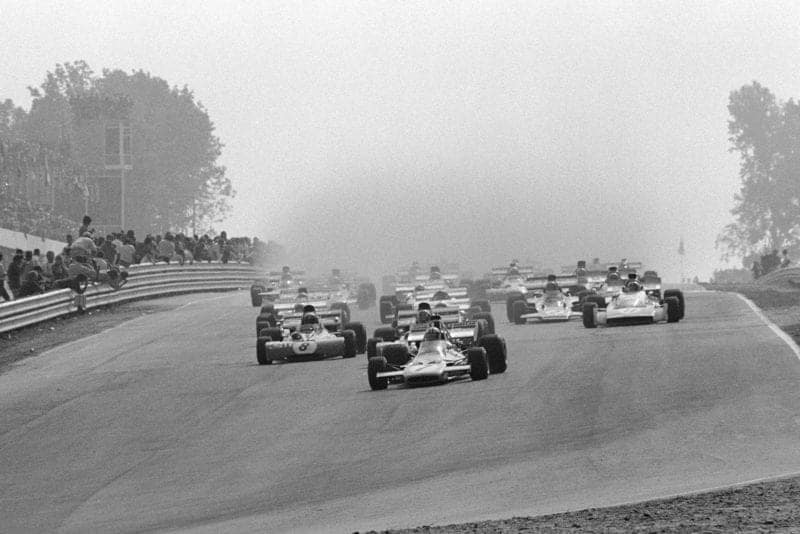
Denny Hulme takes the lead after the starting flag.
Motorsport Images
Race day brought a fair amount of ballyhoo but no supporting races and agonising decisions whether to run softer compound tyres and risk them chunking or the harder ones and play it safe but lose in speed. Of the potential front-runners Peterson was one of the few who decided discretion was the better part of valour. The three warm-up laps produced some drama for Surtees who had to have a sticky pressure relief valve fixed while the two slim-line BRM P160s were topped up with fuel.
Tex Hopkins, that extrovert starter, did his stuff in his now rather faded lavender suit and while he was still in the air there was a crescendo of sound and out of it all Denny Hulme got the jump on the rest with Cevert snaking through into second place and Stewart into third.
Stewart was in no mood to be headed and by the end of the first lap he burst past the pits ahead of Hulme, Cevert and Regazzoni. Then there was the briefest gap to Siffert, then Ickx, Amon, Fittipaldi, Wisell, Beltoise and then Pescarolo, who must have made a tremendous start. As everyone strained to see up the road and watch the rest come through there was a great screech of tyres and Craft spun at the kink before the pits fortunately being avoided by the followers. He stalled the car and had to push it back to the pits, continuing on his way later. Barber had also started late and Cannon had a first lap spin in the country and re-joined half-way down the field on the second lap, which made lap charting very difficult. Revson slowly came into the pits at the end of lap one for his Tyrrell’s clutch was slipping badly due to an oil leak and his car was immediately retired.
The opening ten laps gave the race a very Tyrrell complexion for Stewart was establishing a reasonable lead and Cevert seemed to be in command of second place. Hulme was third but being pressed hard by the Ferraris of Regazzoni and Ickx with Fittipaldi, Siffert and Hailwood all giving good chase. Surtees had made a longish stop with ignition trouble which dropped him to the end of the field although the car sounded good after that while Wisell suffered some brake problem and hit the Armco barrier after five laps and he had to walk back to report to Chapman.
The next few laps brought something of a surprise for rather than pull away from the rest of the field it was noticeable that Cevert with the others in tow were pulling the Scot in. Apparently the Goodyear tyres were starting to lose their effectiveness and the car started to understeer badly. Cevert was on exactly the same compound so one can only assume that Stewart’s car was either set up so differently that it affected them, or that his driving style had something to do with it or that there was a fault in one or more of the tyres themselves. No one from the Tyrrell camp was keen after the race to suggest which alternative was nearest the truth.
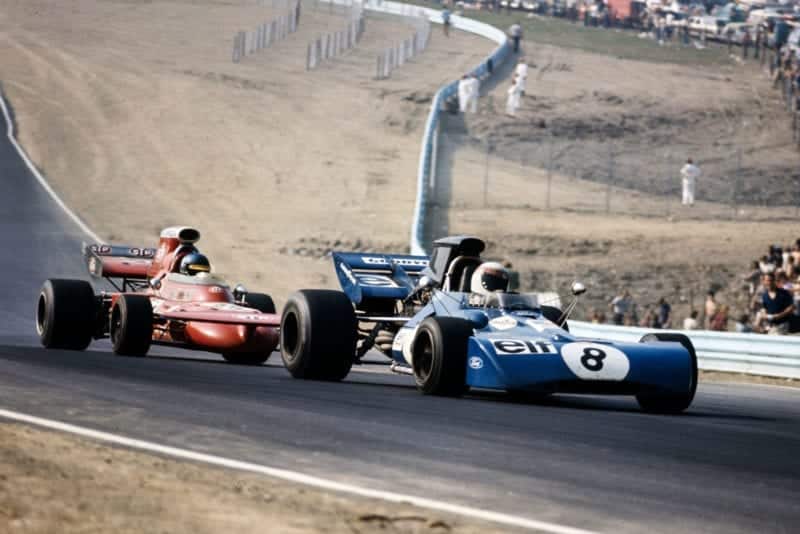
Stewart tries to fend off Ronnie Peterson
Motorsport Images
The bare facts, however, are that on lap 14 Cevert overtook his team-mate and went into a lead he was not to lose while Stewart did his utmost to hold off the pursuing bunch who, in turn, started to slip by. Of these Fittipaldi had made a pit stop with a jamming throttle and after that ran into tyre problems and was never again in the running while Ickx was showing some of his top form and was setting off in chase of Cevert. Stewart was third when lap 20 came around, Siffert had moved to fourth ahead of Regazzoni and Hulme while Hailwood and Peterson were engaged in a furious battle with Ganley getting a grandstand view of it all from ninth place. Galli had gone when someone threw up a huge rock which put a bow into a steering arm, dented the chassis tub and then buried itself in one of the side radiators, while Posey’s race only lasted 15 laps when his engine expired. Pescarolo had slipped down the field after his initial good start and was soon destined to retire with top end trouble in his engine. The racing amongst the first ten was as furious as we have seen it for some time and, although Cevert had a healthy lead, the rest were scratching like mad for every inch of road.
As it approached half-distance the race maintained this pace for Ickx was making a very strong effort to haul in Cevert and undoubtedly seemed to be making up ground when lapping back-markers. The advantage of six seconds was gradually chiselled down to two-and-a-half. In another couple of laps we thought it would be wheel-to-wheel and Cevert would really carve his name as an “ace” if he could hold off Ickx. But it just wasn’t to be and the Ferrari started to slip back for the alternator driven from the rear of the gearbox had fallen apart, the battery was providing electricity for the moment but not for long and the engine seemed to be leaking oil. HuIme had spun off on the oil and clobbered the Armco, bending the front suspension, and now Siffert was third, Stewart fourth with Peterson, Hailwood and Ganley all urging to pass the Champion. Regazzoni had spun, lost time and with 20 laps remaining re-started in eighth place. Hill had methodically moved up and just passed Gethin for ninth position. Marko was tenth ahead of Beltoise and this group was about to be lapped. Both Brabham BT33s had retired, Schenken with fuel pressure trouble and Craft with a broken chassis at the rear.
Despite his problems Ickx clung gallantly on to second place until ten laps later when the old and tired Ferrari would take no more and he free-wheeled into the pits as Siffert passed the start/finish line. Siffert’s second spot was insecure for the BRM was mis-firing at peak revs, and had been doing so for some time. Peterson moved up to third having passed Stewart and lost the shadow of Hailwood who had fallen back with a deflating rear tyre which five laps from the end sent him into a barrier. Ganley moved up to fifth and he too was hard on Stewart’s tail now that the Tyrrell’s tyres were almost through to the canvas. Bonnier ran out of fuel but no one noticed.
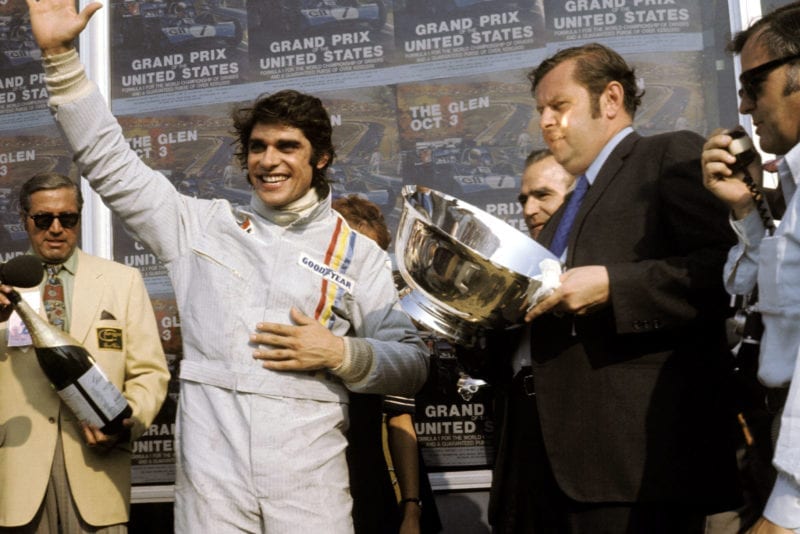
Cevert celebrates his first win
Motorsport Images
Cevert’s lead was now over 30 sec. despite a brush with a guard-rail which could so easily have spelled disaster but didn’t. Luck was on the young Frenchman’s side and he reeled off those last few laps and when Hopkins brought down the chequered flag Cevert flung both arms high in the air. Siffert’s mis-fire was worse but he was a sound, if a little disappointed, second. Ganley’s great drive almost took him past Peterson but the slim line BRM was preciously short of fuel and, like Marko had done a lap before him, he came in for a quick gallon. Parnell waved him on and the gamble paid off for he completed the last lap weaving wildly to pick up the last drop and just held his fourth place—a fine finish to a promising first season. Fifth was Stewart almost catching the BRM while Regazzoni took sixth spot. A lap behind came Hill, Beltoise, Hobbs and de Adamich who had gone somewhat faster than usual. He headed Amon’s sick Matra, the BRMs of Marko and Cannon while Surtees, Barber, Fittipaldi and Lovely completed those still running. For Ickx there was the consolation of the lap record and a prize of $5,000 that went with it. Francois Cevert has arrived.—A. R. M.
